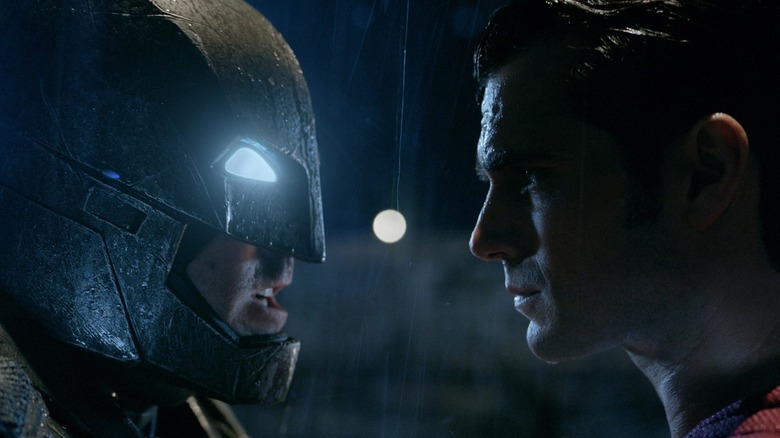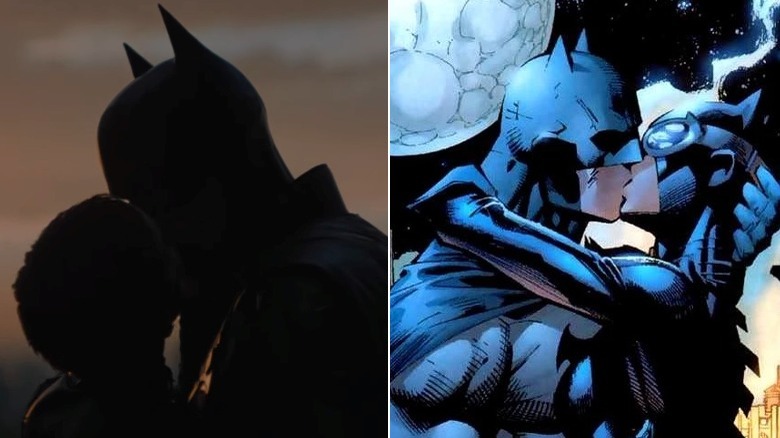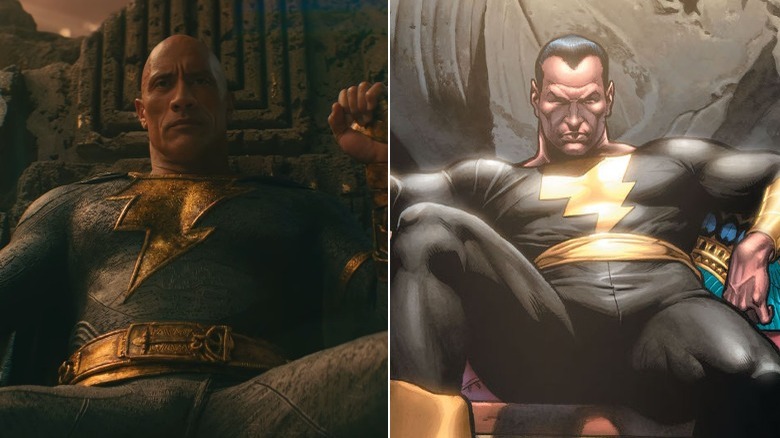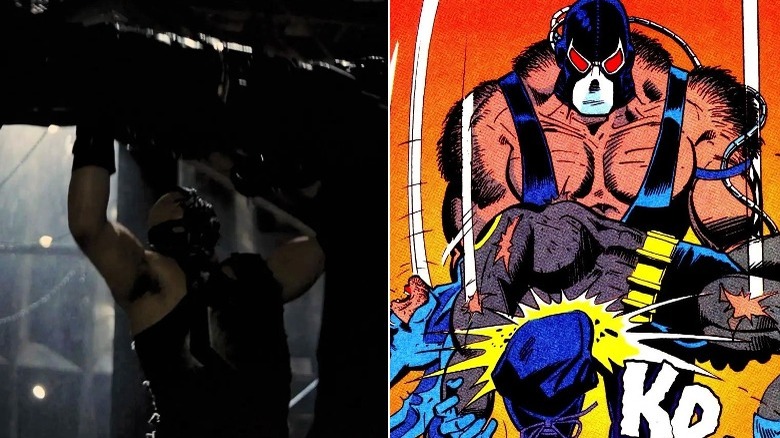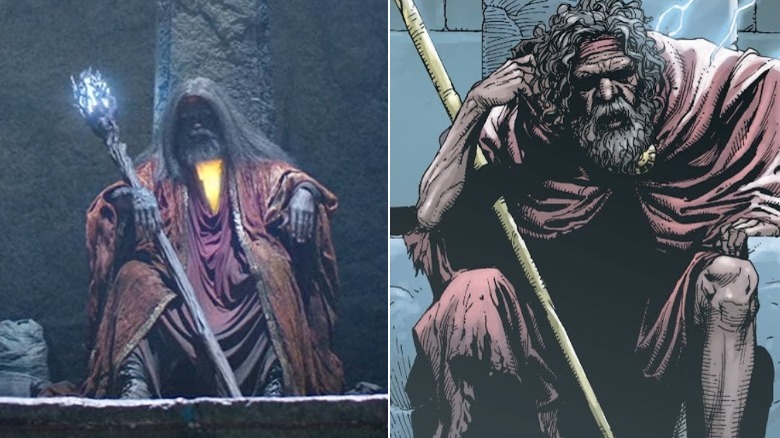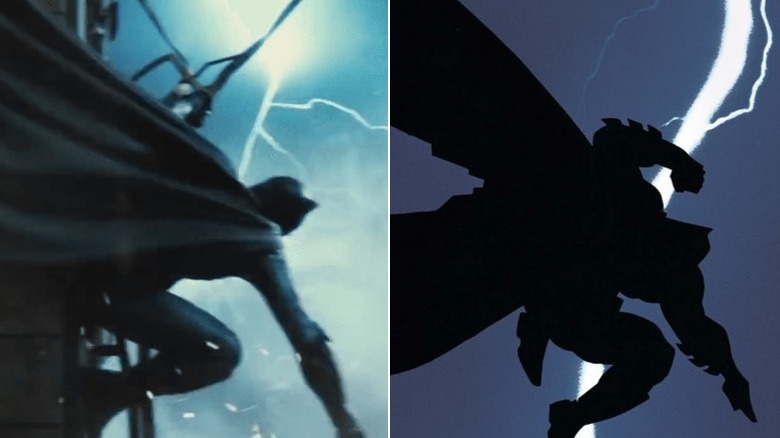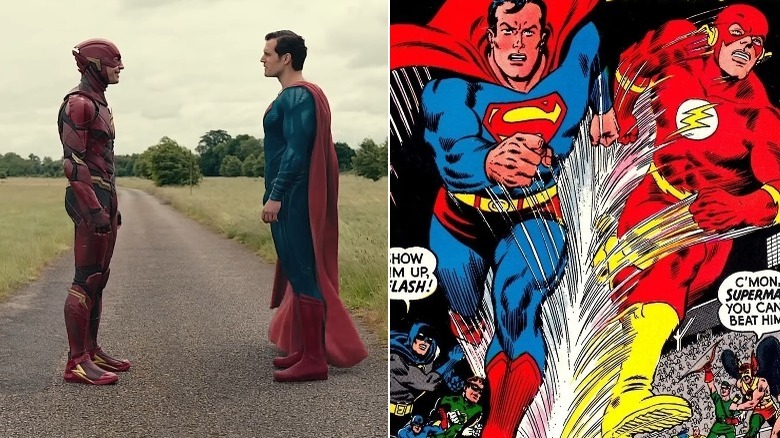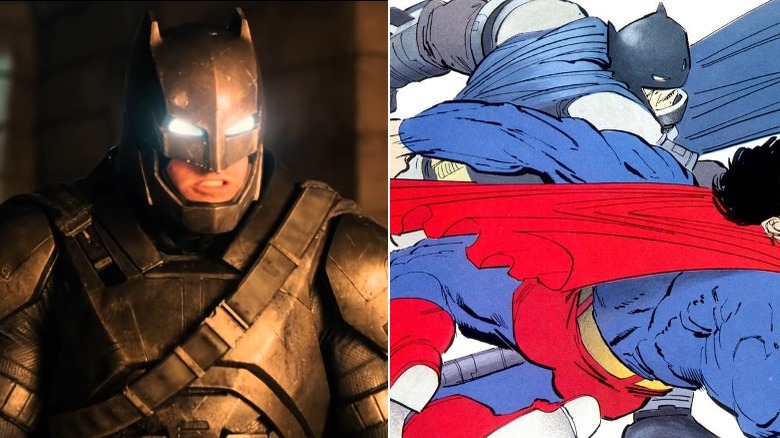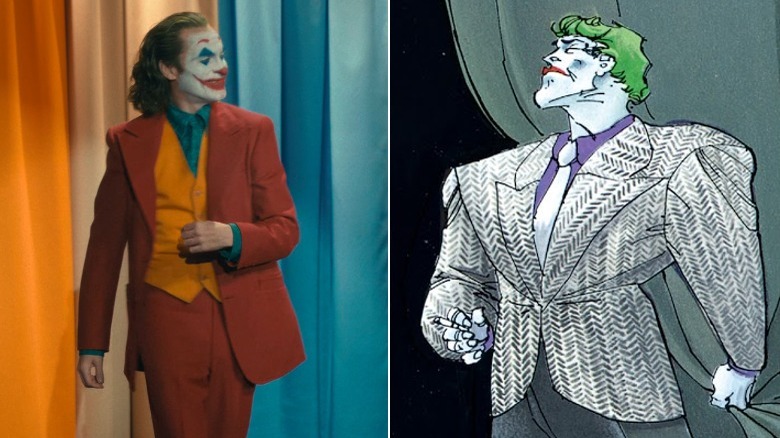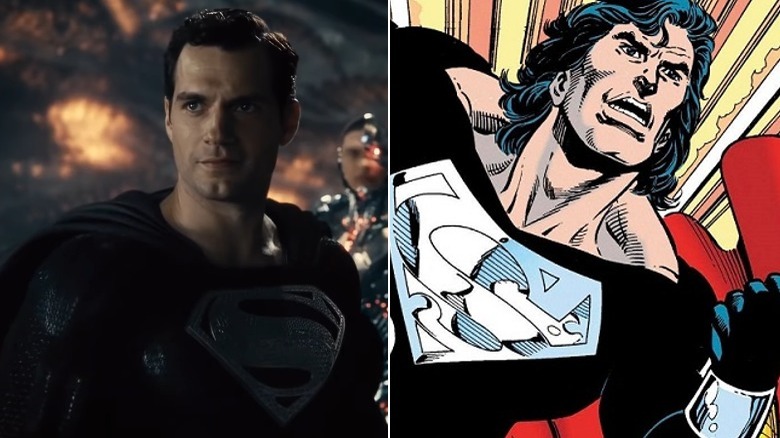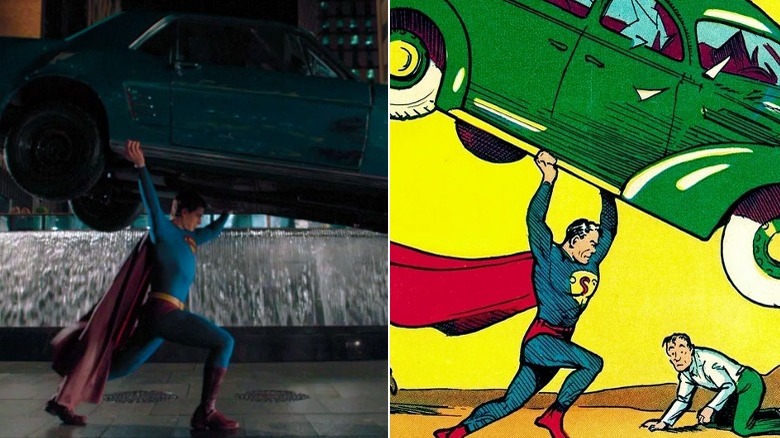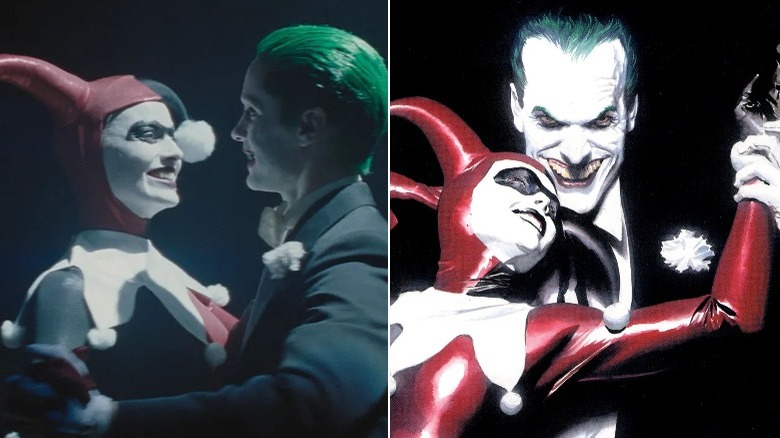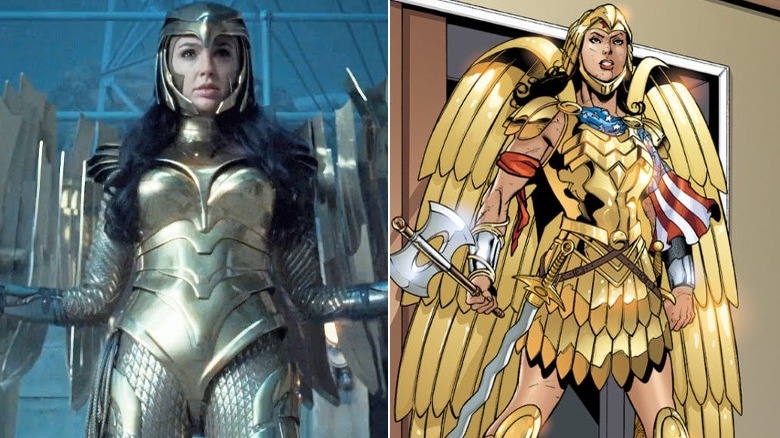DC Movie Moments You Didn't Realize Copied The Comics Exactly
Despite comic book movies having a wealth of source material and stories from which to draw, most adaptations end up growing their own heads and becoming different beasts altogether. Look at DC movies as an example — very few films are beat-to-beat replications of the original arcs they take influence from. The reason for the change-up is straightforward: What works on the page doesn't always translate as well on the big screen.
Then again, there are some iconic movie moments from the comics that simply cannot be ignored by filmmakers. Whether it's a brief tip of the hat or an entire scene that takes inspiration from the funny books, these events turn fans into the living embodiment of the Leonardo DiCaprio pointing meme, screaming at the screen, "I know this reference!"
Considering DC Studios co-CEO James Gunn is a huge fan of the comics, and has used imagery to tease future characters and storylines for the DCU on social media, there will almost certainly be more iconic comic book moments to come in DC movies. Below, some of the best ones that have electrified their films and sent diehard fans into raptures of giddy adulation.
Catwoman and Batman's rooftop rendezvous
If Batman and Catwoman were to update their relationship status on Facebook, it would perpetually read: "Ut's complicated." Whether in the movies, comics, or all the way back to the '60s TV show, it has become clear that these two have serious feelings for each other, but the tights business prevents them from going steady like a normal couple — or perhaps, the messier things get, the more it's a turn-on.
In Matt Reeves' "The Batman," the same holds true in terms of their dynamic. In the last scene of the film, the two meet up on a Gotham City rooftop and have something of a heart-to-heart conversation in the superhero equivalent of the goodbye scene from "Casablanca." A sweet kiss signals that it's time for them to part (for now), as they go off in their separate directions.
"The Batman" takes minor influence from Jeph Loeb and Jim Lee's gritty "Batman: Hush" series. That 12-part story shines a substantial spotlight on the nature of Batman and Catwoman's relationship as well, and the two also share a timeless kiss on a Gotham City rooftop. In additional titles, Bruce Wayne and Selina Kyle have done — ahem — other things on top of buildings. It remains to be seen whether any future films will be gutsy enough to go there.
Black Adam takes the throne
Considering DC's infinite crises of reboots, Teth-Adam has experienced several comic book-based origin stories. Fore the 2022 "Black Adam" film, director Jaume Collet-Serra borrowed a little bit from everywhere while also adding some unique twists.
The film has a few subtle callbacks to the comic books. The biggest of these might be Dwayne Johnson's Black Adam sitting on Kahndaq's throne before he destroys it at the end of the film, insisting people need a protector more than a ruler.
From the way in which Johnson sits on the throne to how he stares ahead for a beat, it's a dramatic recreation of artist J.G. Jones' cover for 2007's "52" #45. That stellar artwork has become a defining image for Black Adam among the fandom, and some fans were happy to see the moment brought to life in the live-action sphere.
Speaking to CinemaBlend, Collet-Serra revealed an important detail about this prop on set.
"No one sat in that throne other than [Johnson]," he said. "You know what I'm saying? The throne was made. We did scenes around the throne. No one ever sat on it. No crew members. There were no pictures taken. That throne is only for him."
Bane breaks the Bat
It's tough to break into the ranks of a rogues' gallery that already includes Joker, Riddler and the Penguin, but Bane solidified himself as a legitimate member within the first year of his debut in the DC Universe. In 1993's "Knightfall" story arc, the Santa Prisca bruiser did something other villains could only dream about: He broke Batman.
In a now-iconic panel from the comics, Bane brings Batman down from a gorilla press, driving a knee into the Dark Knight's back. It was a shocking moment in comic book history, putting Bruce Wayne on the shelf for a while and leading to Azrael taking up the Batman mantle.
Christopher Nolan's "The Dark Knight Rises" takes most of its inspiration from the "No Man's Land" and "Knightfall" storylines. In the movie, Batman goes toe-to-toe with Bane for the first time, and comes out second-best in their round of fisticuffs. Replicating the scene from the comics, the villain hoists the Bat high up in the air and breaks his back. The moment becomes a pivotal plot point, as Bruce is forced to rehab both his body and mind to come back and reclaim Gotham City from Bane's rule. It's also a scene that makes chiropractors around the world weep.
How Billy Batson meets the Wizard
Much like Teth-Adam, Billy Batson's origin story has been tweaked and repackaged, depending on the continuity. For starters, his superhero name was once Captain Marvel — he's now referred to as Shazam, so it goes to show how things have changed for Billy Batson's alter ego since the Fawcett Comics era. For 2019's "Shazam!" film a decision was made to focus on executive producer Geoff Johns and artist Gary Frank's backup "Shazam!" stories in 2012's "Justice League" comic book series.
While the 2019 film ignores the Black Adam element of the story — fairly substantial in the source material — it does wear its influences on its sleeve, borrowing heavily from the tone, imagery, and the sequence of events from the Johns and Frank run. In both the comics and movie, Billy is transported from the subway to the Rock of Eternity where he meets the Wizard for the first time and gains his superpowers. There is also an argument to be made that Djimon Hounsou's version of this wizard is far more exciting, charismatic, and funnier than his comic book counterpart ever became.
The Dark Knight flashes
It's no secret Zack Snyder's "Batman v Superman: Dawn of Justice" is a love letter to Frank Miller and Klaus Janson's "The Dark Knight Returns." Much like that classic story, Snyder's film is about a tired, world-weary Batman who has seen the worst of humanity but still feels driven to fight against the odds and punch in some skulls.
While the events of "Batman v Superman" don't follow the exact same plot as the comic book, Snyder does find the opportunity to recreate the art on screen. One of the more instantly recognizable moments from the comic is a shadowy shot where Batman lands against a wall, then dodges out of the way of an attack from Doomsday. A lightning effect flashes across the sky as the Dark Knight leaps to safety, reminiscent of the gorgeous cover art from "The Dark Knight Returns."
According to Kevin Smith, Ben Affleck is a huge fan of "The Dark Knight Returns" as well, so the actor must have been over the moon to replicate the famed cover pose in this scene. Special credit does need to go out to Snyder, cinematographer Larry Fong, and the visual effects team for making it happen, as this super-cool shot still holds up.
Who is the fastest man alive?
It's funny how most DC movies don't address the real elephants in the room; the questions that fans ask themselves in the quiet moments before they fall asleep. For example, how do people not recognize Clark Kent as Superman when he takes off his glasses? Or does Alfred Pennyworth get paid time and a half for all his nighttime activities?
However, the theatrical cut of "Justice League" teased a response to the pertinent question of who is the fastest man alive: Superman or Barry Allen? While the post-credits scene doesn't provide a definitive answer, it does allude to an event that has happened more than once in the comics.
In 1967's "Superman" #199 by Jim Shooter and Curt Swan, the Man of Steel and the Scarlet Speedster engage in a footrace for the first time at an event for charity. Betting syndicates get involved and try to manipulate the result of the race, but the two heroes overcome the shenanigans and partake in the event — freely and fairly. In case anyone is wondering about the result, it ends in a tie, but it did depict Batman as rooting for the Flash on the cover, while Hawkman is apparently a Superman fan.
Batman vs. Superman
The average moviegoer may have looked at Batman's iron armor in "Batman v Superman: Dawn of Justice" and wondered if the Dark Knight was ripping off Iron Man in his apparel choice. However, the Bat's anti-Superman suit has precedent in the comics, and it's yet another reminder of how the Caped Crusader has some serious trust issues.
In "The Dark Knight Returns," the Man of Steel is sent by the U.S. government to bring in Batman. Supes tries to reason with his old friend, but the Dark Knight is having none of it. Kitted out in a gnarly mech suit with potent accessories, he shows how he has figured out a way to duke it out with Superman and to leave a dent on Big Blue's chiseled jaw.
Notably, the comic storyline didn't have a "Martha" moment where the two men realize their moms have the same name and suddenly decide to instead become super friends. Instead, in the comics Batman has a heart attack during the battle and it ends there. He doesn't die, but this is all part of a master plan to make everyone believe he was.
The Joker loves talk shows
The Clown Prince of Crime has always been all about the performance, showing an appreciation for the lights, camera, and action. The fiend enjoys nothing more than appearing on TV, chatting about himself, and impersonating Oprah by leaving a little something for the audience (let's just say his gifts are more like a permanent vacation).
In the 1986 "Dark Knight Returns" comic the Joker awakens from a catatonic state and convinces everyone it's a good idea to let him go on national TV. Dressed in a spiffy suit, he walks out in front of a live audience, and — well — does typical Joker things, such as setting off a toxin that sends everyone to an early grave.
In 2019's "Joker," Arthur Fleck (Joaquin Phoenix) dreams of appearing on Murray Franklin's talk show and being the man of the hour. Eventually, his time arrives, but at this point, Arthur's transformation into Joker is complete and it isn't Murray's praise he's chasing anymore. He goes on the talk show, provides a soliloquy about himself, and pops Murray in the head on live TV to the horror of the audience and those watching at home. The moral of the story? If Mr. J wants to go on TV, the ratings will be through the roof, but there's a good reason he's been dubbed the Harlequin of Hate.
Does it come in black?
Superman is instantly recognizable in his red and blue signature costume, but that hasn't stopped creators from tinkering with his look. Typically, debates rage about whether or not he should wear red underpants on the outside, but honestly who cares? If the Man of Steel wants to flaunt his preference for skivvies, that's his personal choice and everyone should respect it.
One of the more drastic makeovers Supes has experienced came in the 1993 "Return of Superman" arc, taking place after Doomsday seemingly finished off the Man of Steel. In this story, Superman rises again, but he appears wearing a black suit with silver accessories. The reason for this change in outfit is because it helps the weakened Supes absorb sunlight quicker and accelerates his healing. He also boasts a mullet hairstyle because, well, life is better when it's business in the front and a party at the back.
Longtime fans were distraught when Henry Cavill's Superman didn't don a similar black suit in the theatrical cut of "Justice League." Fortunately, Zack Snyder made it happen in "Zack Snyder's Justice League." While the black suit isn't an exact replica of the one from the comics — nor did Cavill boast a mighty mullet — it's still a nice homage to the source material.
Recreating the action pose
When it comes to Superman art, there are multiple cherished pieces that could be considered legendary. However, there's one image that started it all: The cover for 1938's "Action Comics #1, which marked the official debut of the Man of Steel.
It's a picture that paints a thousand words, particularly in the 1930s, when the thought of a heroic man lifting the weight of a car to save others from danger was nothing short of mind-boggling. In the decades since, it is a pose that has been replicated many times over, reinforced time and again as one of the most recognizable superhero images of all time.
The 2006 film "Superman Returns" paid tribute to the "Action Comics" cover by having Brandon Routh's Superman recreate the image. In recent years, TV's "Superman & Lois" has also copied it with Tyler Hoechlin's Man of Steel; that show, however, took it a step further as Hoechlin wears an old-school costume in a similar vein to the one in the old-timey Fleischer "Superman" cartoons.
The Clown Prince and Princess dance
2016's "Suicide Squad" film introduced a unique take on Joker (Jared Leto) with tattoos, a silver grill, and a desire to not wear a shirt. While such aesthetic decisions divided the fandom, there's little disputing that one of the scenes nails the comic book tone of the Clown Prince and Princess of Crime while providing a DC movie moment hat everyone could get behind.
In the film, there's a quick flashback sequence where a dapper Joker wears a fancy suit and waltzes along with Harley Quinn, kitted out in her jester outfit from "Batman: The Animated Series." Taking into account how the secrecy around DC films is leakier than the Titanic, it's surprising how the studio and filmmakers managed to keep this moment under wraps for the most part until the release of "Suicide Squad."
Of course, it is a scene inspired by artist Alex Ross' sensational photo-realistic cover for 1999's "Batman: Harley Quinn" one-shot. Ross is world-renowned for his artwork and renditions of comic book characters, and he didn't disappoint with this cover, which has since become cherished by DC fans.
Wonder Woman wants all the gold
Wonder Woman's powers make her practically invincible. She can slug it out with gods, aliens, and monsters — walking away without a scratch or hair out of place.
But in 2020's "Wonder Woman 1984," she decided to suit up in a gold eagle armor before facing off against Cheetah and Maxwell Lord, because apparently they are more dangerous than Ares, the God of War. In the film, Diana explains how this mythic armor is made up of all the armor of the Amazon warriors from a bygone era and was worn by the legendary Asteria in battle. While Diana doesn't wear it for very long in the movie, it is a striking design that has become closely associated with the "Wonder Woman" sequel.
It also isn't a creation made solely for the DC movie; Diana has worn gold armor in the comics multiple times. Depending on the continuity, the origin story of the armor varies. There is a version based around the same Asteria legend, while there is another that says the armor was crafted by an Amazon known as Pallas, then given to Diana.
